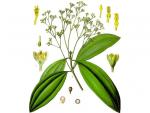Cassia Flower 100% Essential Oil DO NOT ORDER DISCONTINUED
Cinnamomum cassia leaves, steam distilled, from China
Aroma: Cassia oil has a pungent, warm cinnamon-like smell.
History: Also known as Bastard Cinnamon and Chinese Cinnamon, Cassia has been used medicinally in China for several thousand years. Its first recorded use dates back to the Han Dynasty (200 B.D.-A.D. 200).
Colour: Dark brown
Common Uses: Cassia is a tonic, carminative and stimulant. It is used to treat nausea and flatulence. It is also used alone or in combination to treat diarrhea. Chinese and Japanese scientists have found that cassia has sedative effects and lowers high blood pressure and fever in experimental animals. The oil has antiseptic properties, killing various types of bacteria and fungi. Cassia oil is used mainly as a carminative (for relieving colic and griping) or as a stomach tonic. It can also be used for colds, influenza, fevers, arthritis and rheumatism.
Possible Uses: Fragrancing, indigestion, gas, colic, diarrhea, rheumatism, cold/flu. [Julia Lawless, The Illustrated Encyclopedia of Essential Oils (Rockport, MA: Element Books, 1995), 112.]
Constituents: Cinnamic aldehyde, methyl eugenol, salicylaldehyde, methylsalicylaldehyde. [Julia Lawless, The Illustrated Encyclopedia of Essential Oils (Rockport, MA: Element Books, 1995), 112.] Cassia contains 1% to 2% volatile oil (cassia oil), which is mainly responsible for the spicy aroma and taste. Like other bark materials, it also contains tannins, sugars, resins, and mucilage, among other constituents.
Consistency: Medium to Viscous
Note: Top to middle
Strength of Aroma: Strong, sharp
Cautions: Dermal irritant, dermal sensitizer and is a mucus membrane irritant and must be avoided in pregnancy.
Safety Information: Lawless indicates that this oil is a dermal irritant and mucous membrane irritant. [Julia Lawless, The Illustrated Encyclopedia of Essential Oils (Rockport, MA: Element Books, 1995), 112.]
Tisserand advises to completely avoid cassia in skin care applications. [Robert Tisserand, Essential Oil Safety (United Kingdom: Churchill Livingstone, 1995), 204.]
Photo By Honmingjun (Own work) [CC BY-SA 3.0 (https://creativecommons.org/licenses/by-sa/3.0)], via Wikimedia Commons



